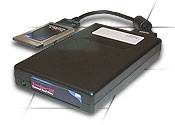[ The PC Guide | Systems and Components Reference Guide | Hard Disk Drives | Construction and Operation of the Hard Disk | Hard Disk Packaging and Mounting ]
External Hard Disks
The vast majority of hard disks are internal, which means they are designed to be mounted inside a PC, and hidden from the user. This is why they have a rather "rough" outside appearance, with the logic board exposed, etc. (For some reason I always liked the way internal drives looked... maybe just because I'm such a storage freak. :^) ) The fact that they are intended to be installed internally is also the reason why they come in standardized form factors--so they will fit inside the PC case in predictable ways. :^)
Some hard disks are available as external drives, especially ones using the SCSI interface. These really don't differ much from internal drives, except that they include an additional outer plastic shell, a power supply to run the disk, and of course, a larger price tag. :^) They do offer some advantages over internal drives: more expandability, easier installation, usually better cooling, and also interoperability with other systems that use SCSI. Since they are external, they don't have to be made in standardized form factors. At one time, these SCSI external drives were more popular than they are today. The higher cost of these drives due to the duplication of support hardware, and the extra space required to put them "somewhere" are probably the main reasons why they are less common today than they once were.
|
The IBM Travelstar E, an external hard |
Image � IBM Corporation |
External drives have found a new market role of sorts as expansion and backup devices for portable computers. Many varieties are now available using either the parallel port or the PC card interface. In the latter design, the hard disk is in an external enclosure, with an interface cable that runs to a PC card. The card connects to the laptop through a PC card slot. The fact that the hard disk is not constrained by the physical limits of the small PC card slot means it can be made much larger than the small drives available in the PC card form factor, while retaining the portability advantages of the PC card interface. Some companies also make just the enclosure itself, with the PC card interface; you supply your own standard internal hard disk. This can save money by letting you "recycle" an older internal drive, and gives you the flexibility of swapping in new drives as better technology becomes available.
![]() Next: Removable Hard Disk Trays
Next: Removable Hard Disk Trays
| The PC Guide
(http://www.PCGuide.com) Site Version: 2.2.0 - Version Date: April 17, 2001 © Copyright 1997-2004 Charles M. Kozierok. All Rights Reserved. |
Not responsible for any loss resulting from the use of this site. Please read the Site Guide before using this material. |
